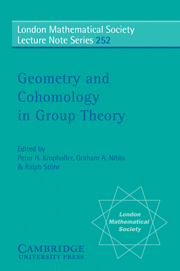Book contents
- Frontmatter
- Contents
- Preface
- List of Participants
- On the Cohomology of SL2(ℤ[1/p])
- Cohomology of Sporadic Groups, Finite Loop Spaces, and the Dickson Invariants
- Kernels of Actions on Non-positively Curved Spaces
- Cyclic Groups Acting on Free Lie Algebras
- Cohomology, Representations and Quotient Categories of Modules
- Protrees and Λ-trees
- Homological Techniques for Strongly Graded Rings: A Survey
- Buildings are CAT(0)
- On Subgroups of Coxeter Groups
- The p-primary Farrell Cohomology of Out(Fp–1)
- On Tychonoff Groups
- Word Growth of Coxeter Groups
- Poly-surface Groups
- Analytic Versions of the Zero Divisor Conjecture
- On the Geometric Invariants of Soluble Groups of Finite Prüfer Rank
- Some Constructions Relating to Hyperbolic Groups
- Free Actions of Abelian Groups on Groups
- Finitely Presented Soluble Groups
Some Constructions Relating to Hyperbolic Groups
Published online by Cambridge University Press: 01 April 2010
- Frontmatter
- Contents
- Preface
- List of Participants
- On the Cohomology of SL2(ℤ[1/p])
- Cohomology of Sporadic Groups, Finite Loop Spaces, and the Dickson Invariants
- Kernels of Actions on Non-positively Curved Spaces
- Cyclic Groups Acting on Free Lie Algebras
- Cohomology, Representations and Quotient Categories of Modules
- Protrees and Λ-trees
- Homological Techniques for Strongly Graded Rings: A Survey
- Buildings are CAT(0)
- On Subgroups of Coxeter Groups
- The p-primary Farrell Cohomology of Out(Fp–1)
- On Tychonoff Groups
- Word Growth of Coxeter Groups
- Poly-surface Groups
- Analytic Versions of the Zero Divisor Conjecture
- On the Geometric Invariants of Soluble Groups of Finite Prüfer Rank
- Some Constructions Relating to Hyperbolic Groups
- Free Actions of Abelian Groups on Groups
- Finitely Presented Soluble Groups
Summary
Abstract. The purpose of this paper is to construct certain quotients, HNN-extensions, amalgamated products and inductive limits of hyperbolic groups, and to apply the results to construct finitely generated verbally complete and divisible groups.
Introduction
The first examples of infinite non-abelian groups, all of whose proper subgroups are cyclic [9], were constructed as inductive limits of hyperbolic groups, although the notion of hyperbolicity was not exploited explicitly. An explicit application of hyperbolic properties for such constructions was proposed in [1] by M.Gromov. This approach was realized in [2].
In the present paper we focus on a method for constructing divisible and verbally complete groups by means of hyperbolic group theory. Recall that a group G is said to be divisible if for any element g of G and any nonzero integer n the equation xn = g has a solution in G.
The groups Q and ℂp∞ are natural examples of divisible groups. For a long period of time, it was unknown whether or not there exist non-trivial finitely generated divisible groups. The first examples were constructed by V.S.Guba [10]. These groups are torsion free. Later on, periodic examples have been given by S.V.Ivanov [7]. Until now it was unknown whether or not there exist non-trivial finitely generated verbally complete groups. Recall that a group G is verbally complete if for any non-trivial word v(x1, …, xn) of the free group F(x1, x2, …) with countable set of generators, and for any element g ∈ G, the equation v(x1, …, xn) = g has a solution in G. We have obtained the following results.
- Type
- Chapter
- Information
- Geometry and Cohomology in Group Theory , pp. 263 - 290Publisher: Cambridge University PressPrint publication year: 1998
- 7
- Cited by

